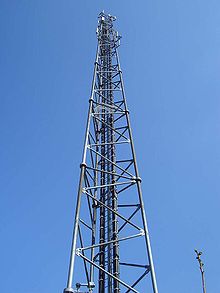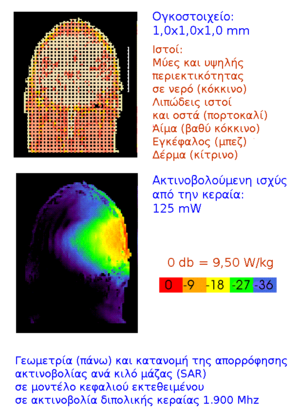الهواتف الخلوية والصحة
أثر إشعاع الهاتف المحمول على صحة الإنسان هو موضع الإهتمام والدراسة في الآونة الأخيرة ، نتيجة للزيادة الهائلة في استخدام الهاتف النقال في جميع أنحاء العالم (as of June 2009[تحديث]حيث كان هناك أكثر من 4.3 مليار مستخدم في جميع أنحاء العالم [1]). الهواتف النقالة تستخدم الإشعاع الكهرومغناطيسي في مجال الميكروويف ، والتي يعتقد البعض أنه قد يكون ضارا بصحة الإنسان. مجموعة كبيرة من البحوث قد تم إجراؤها ، على حد سواء بحوثا من الناحية الوبائية أو التجريبية ، في نموذج حيواني أو نموذج بشرى ، والتى لم تظهر أي دليل شامل للآثار الضارة. النظم الرقمية اللاسلكية والصحة هى أيضا ، مثل شبكات نقل البيانات ، تنتج إشعاعات مماثلة.
وذكرت منظمة الصحة العالمية إستنادا إلى توافق في الآراء في الأوساط العلمية والطبية ، أن السرطان من غير المرجح أن يكون ناجما عن الهواتف الخلوية أو محطات التقوية القاعدية و أن إستعراض التقارير لم بسفر عن وجود أية أدلة مقنعة عن آثار صحية أخرى .[2][3] وتتوقع منظمة الصحة العالمية تقديم توصيات بشأن الهواتف المحمولة في 2010.[4] بعض الهيئات الوطنية الاستشارية للإشعاع [5] قد أوصت بإجراءات لتقليل التعرض لمواطنيها باعتباره من النهج التحوطي .
التأثيرات
حققت العديد من الدراسات العلمية التأثيرات الصحية المحتملة لإشعاعات الهاتف المحمول. أحيانا تتم مراجعة هذه الدراسات من قبل بعض اللجان العلمية لتقييم المخاطر بشكل عام. ونشر مؤخرا تقييما عام 2007 من قبل المفوضية الأوروبية اللجنة العلمية للأمراض المستجدة والمخاطر الصحية التي تم تحديدها حديثا (SCENIHR). [6] ويخلص إلى أن ثلاثة خطوط من الأدلة ، «بمعنى». الحيوانية ، ' وفي المختبر ، والدراسات الوبائية كلها تشير إلى أن "التعرض لمجالات التردد الراديوي من غير المرجح أن يؤدي إلى زيادة في السرطان لدى البشر
إمتصاص الإشعاع
يتم امتصاص جزء من موجات الراديو المنبعثة من سماعة الهاتف النقال من قبل رأس (تشريح) الإنسان. موجات الراديو المنبعثة من قبل جي إس إم سماعة الهاتف يمكن أن يكون ذروة ما تبثه من موجات الراديو طاقة ما قيمته 2 واط واط, وينبعث من هاتف تناظرى أمريكى طاقة قصوى تقدر 3.6 واط تكنولوجيات أخرى رقمية نقالة مثل CDMA2000 و D-AMPS, تستخدم طاقة خرج منخفضة, عادة أقل من 1 واط.,وكذا الإنبعاثات فوق البنفسجية. وينظم انتاج الطاقة القصوى من الهاتف المحمول من حيث معيار الهاتف المحمول والوكالات التنظيمية في كل بلد .[بحاجة لمصدر] في معظم أنظمة الهواتف المحمولة و المحطات القاعدية يتم التحقق من قوة وجودة استقبال الإشارة ومستوى القوة إما بزيادة أو نقصان تلقائيا ، في غضون فترة معينة ، لاستيعاب الحالات المختلفة مثل داخل أو خارج المباني والسيارات. يتم قياس المعدل من الإشعاع الذي يمتصه الجسم البشري من قبل معدل امتصاص محدد (SAR), وتم تحديد المستويات القصوى بالنسبة للأجهزة الحديثة والوكالات الحكومية هى التي تنظم ذلك في العديد من البلدان. في الولايات المتحدة ،و اللجنة الاتحادية للاتصالات (لجنة الاتصالات الفدرالية)(FCC )وقد وضعت حدا SAR من 1،6 واط / كج وبلغ متوسط حجم الإنبعاثات أكثر من 1 جرام من الأنسجة, للرأس. في أوروبا, يبلغ الحد قراب 2 واط/كج, وبلغ متوسط حجم الإنبعاثات أكثر من 10 جرام من الأنسجة. قيم (SAR) تعتمد اعتمادا كبيرا على حجم وحدة التخزين في المتوسط. من دون معلومات عن حجم متوسط الطاقة المستخدمة ، لا يمكن أن تتم المقارنة بين قياسات مختلفة . وبالتالي ، فينبغي مقارنة هذا التقييم الأوروبي بقيمة 10 جرام فيما بينها ، وينبغي تقدير التقييمات الأمريكية فقط 1 جرام يمكن مقارنتها فيما بينهما. ويمكن الاطلاع على البيانات الخاصة (SAR) لهواتف نقالة محددة ، جنبا إلى جنب مع غيرها من المعلومات المفيدة ، مباشرة من مواقع المصنعين ، فضلا عن مواقع طرف ثالث .[7]
تأثيرات حاجز المخ-الدم
وقد درس باحثون سويديون من جامعة لوند (سالفورد ، برون ، Perrson ، ايبرهارت ، وMalmgren) آثار إشعاع الميكروويف على أدمغة الفئران. ووجد الباحثون تسرب الزلال إلى الدماغ عن طريق تخلل الحاجز الدموى- المخى.[8][9] وهذا يؤكد العمل والأبحاث في وقت سابق على حاجز الدم في الدماغ عن طريق ألان فراي ، أوسكار وهوكينز ، وألبرت وكيرنس .[10] مجموعات بحثية أخرى لم تؤكد هذه النتائج على الخلايا [11]أو حيوانات التجارب.[12]
السرطان
في عام 2006 نشرت دراسة كبيرة دنماركية حول العلاقة بين استخدام الهاتف المحمول والإصابة بالسرطان. جاء ذلك خلال أبحاث أجريت على 420،000 من المواطنين الدانمركيين لمدة 20 عاما ولم تظهر أي زيادة تشمل خطر الاصابة بالسرطان .[13]المكتب الفيدرالي الألماني للحماية من الإشعاع (BfS) يرى أن هذا التقرير غير حاسم[14]
وقد نشرت الدراسات التالية عن التعرض لفترات طويلة :
- إن 13 مشروعا وطنيا project INTERPHONE -- وهو أكبر دراسة من نوعها التي أظهرت أكثر من أي وقت مضى -- وقد تم الآن نشرها ولم تجد أية صلة متينة تربط الهواتف المحمولة بأورام المخ.
و قد نشرت «المجلة الدولية لعلم الأوبئة»
[15] a combined data analysis from a multi national population-based case-control study of glioma and meningioma, the most common types of brain tumour.
The authors reported the following conclusion:
Overall, no increase in risk of glioma or meningioma was observed with use of mobile phones. There were suggestions of an increased risk of glioma at the highest exposure levels, but biases and error prevent a causal interpretation. The possible effects of long-term heavy use of mobile phones require further investigation.
In the press release[dead link] accompanying the release of the paper, Dr Christopher Wild, Director of the International Agency for Research on Cancer (IARC) said:
An increased risk of brain cancer is not established from the data from Interphone. However, observations at the highest level of cumulative call time and the changing patterns of mobile phone use since the period studied by Interphone, particularly in young people, mean that further investigation of mobile phone use and brain cancer risk is merited.
A number of independent health and government authorities have commented on this important study including The Australian Centre for Radiofrequency Bioeffects Research (ACRBR) which said in a statement that:
Until now there have been concerns that mobile phones were causing increases in brain tumours. Interphone is both large and rigorous enough to address this claim, and it has not provided any convincing scientific evidence of an association between mobile phone use and the development of glioma or meningioma. While the study demonstrates some weak evidence of an association with the highest tenth of cumulative call time (but only in those who started mobile phone use most recently), the authors conclude that biases and errors limit the strength of any conclusions in this group. It now seems clear that if there was an effect of mobile phone use on brain tumour risks in adults, this is likely to be too small to be detectable by even a large multinational study of the size of Interphone.
انظر أيضاً
- Background radiation
- Bioelectromagnetism
- BioInitiative Report
- COSMOS cohort study
- Electrical sensitivity
- Electromagnetic radiation and health
- Microwave News
- Mobile phones and driving safety
- Non-ionizing radiation
- Possible health effects of body scanners
- Radiation biology
- Specific absorption rate
- Wireless electronic devices and health (computer data wireless)
الهامش
- ^ "Market Data Summary (Q2 2009)". GSM Association. Retrieved 2010-01-30.
- ^ "What are the health risks associated with mobile phones and their base stations?". Online Q&A. World Health Organization. 2005-12-05. Retrieved 2008-01-19.
- ^ "Electromagnetic fields and public health: mobile telephones and their base stations". Fact sheet N°193. World Health Organization. 2000. Retrieved 2008-01-19.
{{cite web}}: Unknown parameter|month=ignored (help) - ^ Health and Environment - Science Milestones
- ^ "Information: Wie gefährlich sind Handystrahlen wirklich?" (in German). Marktgemeinde Pressbaum. Retrieved 2008-01-23.
{{cite web}}: CS1 maint: unrecognized language (link) - ^ "Conclusions on mobile phones and radio frequency fields". European Commission Scientific Committee on Emerging and Newly Identified Health Risks (SCENIHR). Retrieved 2008-12-08.
- ^ For example, two listings using the European 10 g standard: of more current models at "Mobile Phones UK". Mobile Phones UK web site. Landmark Internet Ltd. Retrieved 2008-01-19.; of phones from 2005 and earlier at "The Complete SAR List For All Phones (Europe)". On-Line-Net - Web Design & Internet Services (as SARValues.com). Retrieved 2008-01-19. (a listing of US phones from 2005 and earlier, using the US 1 g standard, is also available at the SARValues site)
- ^ Salford, Leif G. (2003). "Nerve Cell Damage in Mammalian Brain after Exposure to Microwaves from GSM Mobile Phones". Environmental Health Perspectives. الولايات المتحدة: National Institute of Environmental Health Sciences. 111 (7): 881–883. doi:10.1289/ehp.6039. PMC 1241519. PMID 12782486. Retrieved 2008-01-08.
{{cite journal}}: Cite has empty unknown parameters:|laysummary=,|laydate=,|laysource=, and|quotes=(help); Unknown parameter|coauthors=ignored (|author=suggested) (help); Unknown parameter|month=ignored (help) - ^ Salford, Leif G. (2008). "The Mammalian Brain in the Electromagnetic Fields Designed by Man with Special Reference to Blood-Brain Barrier Function, Neuronal Damage and Possible Physical Mechanisms". Progress of Theoretical Physicsupplement. Japan: Physical Society of Japan. 173: 283–309. doi:10.1143/PTPS.173.283.
{{cite journal}}: Cite has empty unknown parameters:|quotes=and|month=(help); Unknown parameter|coauthors=ignored (|author=suggested) (help) - ^ Frey, Allan. "Headaches from Cellular Telephones: Are They Real and What Are the Implications?". Environmental Health Perspectives.
- ^ Electromagnetic fields (GSM 1800) do not alter blood-brain barrier permeability to sucrose in models in vitro with high barrier tightness, Franke et al., Bioelectromagnetics, 26(7):529-535 at http://dx.doi.org/10.1002/bem.20123
- ^ Lack of effects of 1439 MHz electromagnetic near field exposure on the blood-brain barrier in immature and young rats, Kuribayashi et al., Bioelectromagnetics, 26(7):578-588 at http://dx.doi.org/10.1002/bem.20138
- ^ Schüz, J (2006). "Cellular Telephone Use and Cancer Risk: Update of a Nationwide Danish Cohort". Journal of the National Cancer Institute. 98 (23): 1707–1713. doi:10.1093/jnci/djj464. PMID 17148772. Retrieved 2008-01-20.
Among long-term subscribers of 10 years or more, cellular telephone use was not associated with increased risk for brain tumors ..., and there was no trend with time since first subscription. ...CONCLUSIONS: We found no evidence for an association between tumor risk and cellular telephone use among either short-term or long-term users. Moreover, the narrow confidence intervals provide evidence that any large association of risk of cancer and cellular telephone use can be excluded.
{{cite journal}}: Cite has empty unknown parameter:|quotes=(help); Unknown parameter|coauthors=ignored (|author=suggested) (help); Unknown parameter|month=ignored (help) - ^ "Comments on the Danish cohort study on mobile phones" (in German). Bundesamt für Strahlenschutz [Federal Office for Radiation Protection]. 2007-02-22. Retrieved 2010-09-23.
{{cite web}}: CS1 maint: unrecognized language (link) - ^ INTERPHONE Study Group (2010). "Brain tumour risk in relation to mobile telephone use: results of the INTERPHONE international case–control study" (PDF). International Journal of Epidemiology. 39 (3): 1&ndash20. doi:10.1093/ije/dyq079. PMID 20483835.
وصلات خارجية
- Summary and full text of "Possible effects of Electromagnetic Fields (EMF) on Human Health", the 2007 scientific assessment of the European Commission's SCENIHR (Scientific Committee on Emerging and Newly Identified Health Risks).
- WHO International EMF Program
- Independent Expert Group on Mobile Phones (IEGMP), UK
- FDA Cell Phone Facts
- FCC Radio Frequency Safety
- Medline Plus, by US National Library of Medicine and National Institutes of Health (NIH)
- GSM Association: Health

